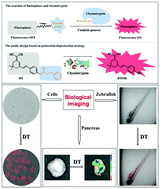A non-peptide probe for detecting chymotrypsin activity based on protection–deprotection strategy in living systems†
Abstract
Chymotrypsin (CHT) plays a vital role in the metabolism of organisms and affects cell proliferation and apoptosis. Abnormal levels of CHT will lead to a variety of diseases, such as inflammatory arthritis, diabetes, pharyngitis, indigestion, and pancreatic cancer. Therefore, it is significant to design an effective method for the detection of CHT in living systems. Here, we synthesized a specific deep-red non-peptide probe DT by effectively combining isophorone and p-hydroxybenzaldehyde for the detection of CHT using 3-phenylpropionate chloride as the recognition group based on a protection–deprotection strategy. The DT probe exhibited an emission range of 525–700 nm and showed excellent photostability, high sensitivity (LOD = 0.071 U mL−1), and selectivity for CHT detection. The cellular experiments demonstrated that DT could sensitively recognize CHT activity in three cell lines and the content of CHT was much higher in P815 cells than in MCF-7 and 3T3 cells. Also, DT was successfully used to visualize the endogenous CHT in zebrafish. Notably, the DT probe provided an intuitive way to visualize endogenous CHT in mouse pancreas for the first time, demonstrating the potential for application in the future clinical diagnosis of pancreatic diseases. Therefore, the small-molecule probe DT is expected to be a useful molecular tool for CHT-related disease diagnosis and drug discovery.



 Please wait while we load your content...
Please wait while we load your content...